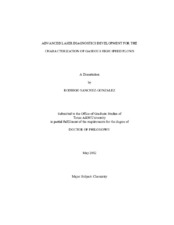| dc.description.abstract | The study of high-speed flows represents a challenging problem in the fluid dynamics field due to the presence of chemical reactions and non-equilibrium effects. Hypersonic flights, where speeds reach Mach 5 and above, are particularly influenced by these effects, resulting in a direct impact on the flow and consequently on the aerodynamic performance of a vehicle traveling at these speeds. The study of hypersonic flow conditions requires the experimental capability of determining local temperatures, pressures and velocities using non-intrusive techniques. Furthermore, the simultaneous measurement of two or more variables in a complex flow boosts the amount of information that is obtained since valuable correlations can be established.
This research includes the design, construction and characterization of a hypersonic flow apparatus explicitly intended as a tool for advanced laser diagnostics development. This apparatus is characterized by its pulsed operation mode that translates into a significant reduction in mass flow rates and can be operated for long periods at Mach numbers ranging from 2.8 to 6.2. The flow conditions during the uniform flow time interval of each pulse vary by less than 1%, generating a flow of sufficient quality for quantitative measurements.
The development of a laser diagnostic technique, the VENOM technique, which is a non-intrusive method to provide simultaneous 2-D measurements of the mean and instantaneous fluctuations in two-component velocity and temperature is also presented. This technique represents the first single diagnostic capable of instantaneous two-component velocimetry and thermometry in a gaseous flow field by combining two Nitric Oxide Planar Laser Induced Fluorescence methods: two-component Molecular Tagging Velocimetry and two-line thermometry, employing the nascent NO(v"=1) arising from the NO2 photodissociation as a molecular tracer. The VENOM technique is expected to be not only applicable to cold high-speed flows, which is the focus of the present work, but also to combustion and other reactive or high-enthalpy flow fields. | en |


